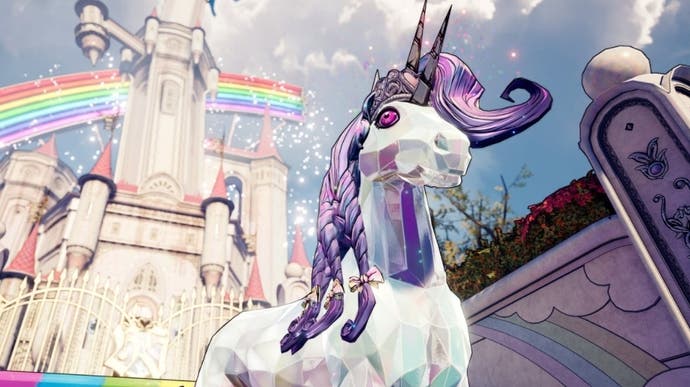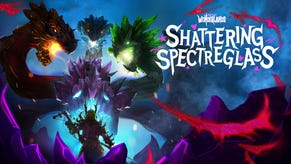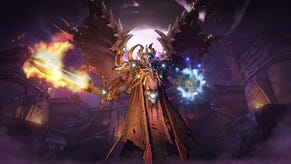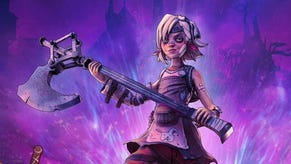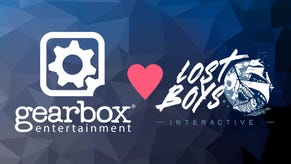Flipping the tabletop with Borderlands' new Tiny Tina's Wonderlands
Boarderlands.
When the reveal trailer for Tiny Tina's Wonderlands was released, I had no idea I was watching gameplay from the developer of Borderlands. That's partly because I have the memory of a goldfish, but more fundamentally, it's because this isn't just another Borderlands game.
Instead, this is a game that will stand on its own. Sure, it's inspired by Borderlands 2's Assault on Dragon Keep DLC, which develops the character of Tiny Tina (voiced by Ashly Burch), and whose namesake is part of the game's title. But it isn't just an expansion of Assault on Dragon Keep or another fantasy looter shooter (though it certainly has those elements).
For the studio, Tiny Tina's Wonderlands is a fresh start with a fundamental change in gameplay that makes the whole thing unique. That fundamental change is the tabletop, where all the perceived gameplay takes place.
It's a mighty challenge to not only make the transition between the board game and first-person elements feel seamless, but also to make the tabletop mode just as interesting as the first-person elements. So the team took inspiration from Dungeons & Dragons, but also from classic JRPGs like Final Fantasy and action-adventures like The Legend of Zelda. At one point the team even experimented with a style akin to Heroscape before abandoning it because it didn't provide the right level of interactivity.
The team eventually settled for a three-layered world, consisting of the 'real' world with players standing over the table; the overworld which sits between the real world and the first person perspective; and the actual game world where the first-person looter shooter gameplay you've come to expect takes place.
And as might have guessed, anything that happens on one layer affects the others. A spilt fizzy drink can on the game board will create a winding river in the game world which players have to traverse. When a dice is sitting on the table, in the overworld that same dice is covered in moss and has become part of the environment.
To learn more, I had the pleasure of speaking with three senior members of the development team: creative director Matt Cox, art director Adam May, and senior level designer Gabriel Robitaille.
Regarding the overworld, you have mentioned how a can of soda dropped on the board is something visible in the game world. To what extent are these changes dynamic and impacted by player choice? In other words, can the player change the game world or is it mostly linear and based on the progression of the story?
Matt Cox: It's really the context of Tina narrating the game, because there's even a Cheeto that the left on the board, and she has to pretend like she totally meant to leave the Cheeto there because she gets called out like, "Did you leave a Cheeto on the board"? And she says "No, that's not me" and it becomes a whole dungeon quest. So, it's really at the wiles of what Tina decides to do.
In the context of the story, you've said that this game is a standalone release that holds its own. But we saw recently the Assault Dragon Keep DLC release as a standalone game. How important do you think it is that players should get some sort of context and experience of Tina as a character before they really start off with this game?
Matt Cox: I would say none. I think Wonderlands can be your first experience in the Borderlands universe and you won't be lost. I think it's great that we did Assault on Dragon Keep because I think it reintroduces people to the style of game within a game and the looter shooter in a fantasy setting. So, if you've never seen or experienced Tina before, it would be a cool intro primer to her personality, but as far as understanding what's happening in the story, you won't need to have played any other game.
A related question, will the game be canonically a sequel to the DLC? What part of the timeline does it take place in outside the board game story?
Matt Cox: Shortly after the events of Assault on Dragon Keep, so we're obviously back. I mean, people can recognise she's 13-year-old Tina, not as she is in Borderlands 3.

Will the story outside of Wonderlands, in the wider Borderlands universe, also have some added details, or is it very concentrated on Wonderlands itself?
Matt Cox: It's definitely more about what happens at the table and in the world. I think that's one of the great freedoms we have of being inside the imagination of a 13-year-old, where a lot of the things that she comes up with allow us to invent new stories.
Adam May: There are a lot of cool little titbits and nuggets of information that if you're familiar with Borderlands and Tiny Tina's Assault on Dragon Keep, you'll pick up on those and it will bring extra layers of depth. But none of it is dependent specifically on you knowing or being familiar with them.
Matt Cox: You saw Torgue in there, so people that love Torgue are gonna see him again. But those who've never experienced Torgue can be like, "Wow, this is wild, crazy character."
In terms of the melee weapons, you placed a lot of emphasis on that and magic. In terms of the development of those weapon types: do we see the same level of development we saw with weapons in Borderlands games where there are a bunch of different varieties along with loot?
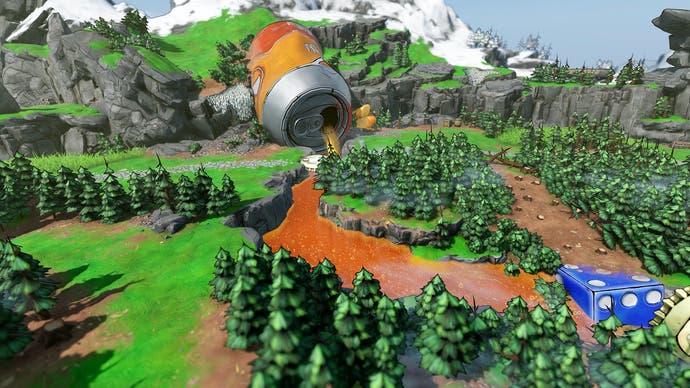
Matt Cox: Absolutely, we wanted to have the same procedural tech that drives our guns also drive our spell books and our melee weapons, and to some degree, our armour as well. So, it's made up of a bunch of different pieces that can all get mixed and matched together depending on rarity. And they all roll very similarly to guns. So, it was very important to us that the types of loot that people are used to in our brand of game aren't just like little orbs of something, it's actually loot that you find, that rolls with different parts.
Adam May: We could go on for hours and hours about it! Borderlands had a lot of loot, Wonderlands is unbelievable. We added several new types of loot that Borderlands didn't even have. We have amulets and rings, as well as a whole armour gear set for characters that we call armour, but it's actually not technically like armour, it's more like a cosmetic effect that holds extra perks for your character classes. There's just a whole slew of them that have different visual styles that you get to customise on top of all the customizations in the character creator, and man our character creator has so many options in it.
What's really neat about it, too, is that all the extra cosmetic options are actually part of our loot loop. So you start the game with a whole lot of really cool options. But since you can change and update your visual representation in the game from a New-U Station as you play through, that's actually part of the loop as well. So we have real epic skins and cosmetic options, like whole head styles and skin styles, where it's not just like colours, but actual materials where you can have diamond skin, or gold skin or glowy skin.
And with our characters, we didn't want you to just be stuck to standard fantasy classes. This is a whole new world. So you can be fish-people, or dragon-people, or Orcs, or really anything you want. The amount of customization we unlock for the players is ridiculous. We even have asymmetricity, you can take one eye and move it off and make it big and googly as well. So there's just a limitless number of different customization between the tattoos and the helmets and hats and hair and makeups and yeah, it's just endless.
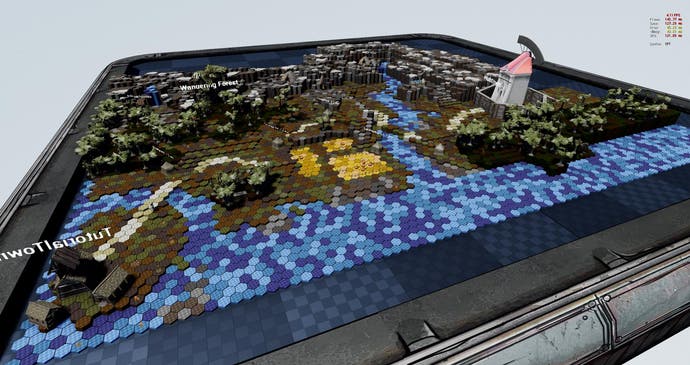
Speaking of characters, in Borderlands 3, characters have their own dialogue and they respond to things that other characters say in the world. Does that carry on with Wonderlands?
Matt Cox: Absolutely. And it even goes further because you'll be able to choose your different personalities in the character creators. So, we have different personalities and different voice actors that voiced these personalities. So Brave for instance, has two different voice actors you can choose from, and you have a pitch slider, so you can slightly change the pitch of the actual actor. So, you can really dial in how you want to sound within the choices that we've given you.
Adam May: Something really fun that I personally was really concerned about at the beginning of the project, because we've done such a good job in the borderlands universe of making characters feel like they have character, both in the way they look and their voices and everything. That was that was a real challenge, if you're able to create anything, how do we actually make sure you don't just end up in a generic sort of grey space if you can modify all those things? You can make as unique and wild looking characters you want but the voice adds so much to it. It really does like let you really create a character inside the game that says and reacts to things as you play that makes it just fun even to listen yourself talk.
On melee weapons, we know it has a dedicated slot, but does it have some deeper melee combat than a single-button offer?
Matt Cox: The mechanic was overall the same, but the utility and the usefulness of melee is so much more than it was in previous games, for instance, you can collect blunt swords, axes and other different types of weapons. And all of those have different speeds, power, and bonuses. For instance, you can find bonuses on melee weapons that return ammo, or spell cooldowns. So if you get into this combat loop, where you love spells, and you want them to cool down as quickly as possible, you're going to search for that piece of melee gear that returns that to you. You will be pressing the melee button way more than before, but it is still a secondary ability. Over the course of development, as we've been tuning this loop, people really started to integrate melee weapons and spells in a variety of different ways. So melee is much more important. But it's still very action-focused for sure.
Gabriel Robitaille: And also, that's why you want to melee in the overworld, because, as soon as we started using it in the first-person, it started to feel so right. And when we were trying the random encounter [system], the first thing we had in terms of design was either you engage or you avoid them. I don't want to avoid people in this game, I want to punch them, it's just the way I want to deal with them. So, we use that feature right away in the overworld and it felt so right.
Final thing just on the releases. So we do have a next-gen game, has that changed the game's development? For example, in previous titles the wider world was broken up into smaller segments with loading transitions, has that changed for the new consoles?
Matt Cox: We definitely developed this game for all consoles, all the previous gen and the current gen consoles. So for the bigger maps, you still have your traditional load screens for those giant first-person maps, but you can pop in and out of random encounters seamlessly in the overworld. as you're doing these smaller bite size dungeons and random encounters, those are all streamed in. So it's not like hard loads as you're travelling in the overworld.
